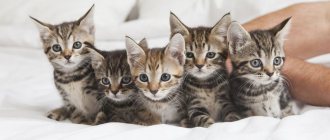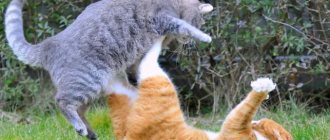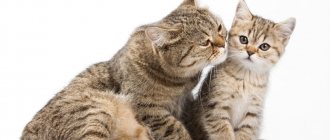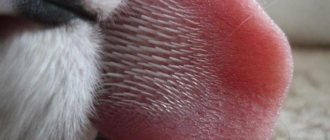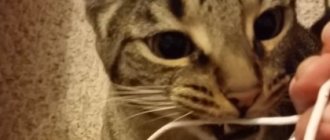Domestic cats are traditionally portrayed as good-natured and affectionate creatures, although expert opinions paint a completely different picture. According to the observations of experts, every cat is prone to demonstrating undisguised anger, and often uses aggression unmotivated when it strives for dominance and submission to its will.
Let's find out which cats are on the list of the most dangerous breeds, and also figure out how to avoid attacks from them.
TOP aggressive cat breeds
The list of the most aggressive cat breeds sometimes includes quite harmless animals that people simply have not found an approach to.
Maine Coons
The Maine Coon cannot be called completely safe, but it should not be classified as an evil pet either. Three external signs are enough to draw a conclusion about potential danger and innate anger:
- powerful body on large paws;
- a wary and stern predatory look;
- lynx tufts on the ears and measured, noiseless gait.
Cats of this breed resist excessive affection and can defend their food like a dog. In fact, the Maine Coon is absolutely harmless, and under normal conditions it will never take threatening actions. It is almost impossible to bring him into an attack of aggressive anger.
Balinese people
Representatives of the Balinese cat breed owe their aggressiveness to the Siamese. They have an explosive temperament, which is uncontrollable at the moment of active outburst.
Even being alone for a long time can make a Balinese angry. In this case, the owner will be greeted not by a gentle, sociable cat, but by an angry predator who can dig his claws into the hands outstretched to him.
Important! A characteristic feature of this cat is its dislike for strangers. She is not ready to demonstrate loyalty to all humanity and sometimes shows aggression for no reason.
British cats
An indigenous English breed that is included in the list of evil cats due to its difficult character. At first glance, one cannot suspect them of innate aggressiveness. This is exactly the case when appearances are deceiving, and laziness is feigned.
This breed of cat is not characterized by direct and causeless anger. But she is very proud, touchy, selfish and prefers solitude. Violation of any of the listed points becomes a reason for the cat's discontent. And it is expressed by those means that are available to the animal - claws and teeth.
True, before attacking the “offender”, the Briton will try to leave so as not to enter into conflict.
Scottish cats
The Scots are less aggressive than their British ancestors. Although, for the purpose of protection, they are capable of showing signs of anger - they can hiss, bend, fan their tail and raise the fur on their spine. Most often, after such a session of “intimidation”, even the most evil Scottish cats hide in a secluded place.
Savannah
The Savannah (a hybrid of an ordinary cat and a wild African serval) has a very complex pedigree line. Breeders wanted to combine the natural appearance of the spotted serval with the docile nature of a domestic cat.
They managed to achieve their goals, but the savannah cannot be called an animal that has fully adapted to living in a family. The innate qualities of an angry night hunter take their toll, and the impressive size (height at the withers reaches 60 cm) and the habit of attacking from the back look menacing.
In the 3-4th generation, Savannahs (wild blood content is about 10-25%) are quite friendly towards people, demonstrate a desire to communicate and are easy to learn. They even walk on a leash, sniffing with interest everything that comes along the way.
Important! During the mating season, cats' behavior changes dramatically. At this moment they become angry and aggressive - this reaction is caused by a natural desire to fight for procreation.
Reflexive anger of an animal
The most obvious and easily understood type of anger occurs between inexperienced males. When males reach adulthood, they often begin to challenge each other for access to females and territory. Aggression between indoor cats is more subtle and complex than conflicts between two outdoor males.
Redirected aggression is the most dangerous type of cat aggression because the biting becomes unrestricted and the attacks can be frightening and destructive. Unfortunately, this is a very common type of cat aggression. Redirected aggression occurs when a cat becomes aggressively aroused and agitated by an animal or person that it cannot reach (for example, because there is a window between them).
Unable to reach the trigger of her anxiety, she turns and lashes out at someone nearby or who is approaching him. There can be a significant delay, up to hours, between initial arousal and redirected aggression. This is why cat owners sometimes describe this type of aggression as unprovoked or “out of the blue.”
They didn't even know about the original trigger (like the cat outside that passed 30 minutes before the attack). A redirected attack only occurs if someone appears nearby. The animal will not go looking for someone to attack. Redirected aggression is not an evil or deliberate type of aggression, it is almost like a reflex, done automatically without thought.
It is important to understand that any cat does not become evil just like that. There is always a reason for the anger of an animal, just like a person. The main task of the animal owner is to establish the cause of aggression and eliminate it. This will allow you to enjoy spending time with your pet, and will help the animal feel happy and healthy.
Predatory cats
Scientists have long confirmed that all modern cats descended from 5-10 species of evil wild animals. Breeders continue to crossbreed different breeds in hopes of creating the perfect wild-looking cat. Most often, such efforts end in a genetic fiasco or natural anger takes over.
Then the seemingly harmless animal becomes a serious threat to others. To understand the danger of such connections, it is necessary to understand which of the wild ancestors represent the parental line of the pet.
jungle cat
A large predatory animal in a brown-gray color, with tufts on the ears and the character of a hunter. Males grow up to 90 cm. Such a pet can be kept in the house, especially if upbringing begins in childhood.
Evil jungle cats always guard their territory, according to the centuries-old instinct of dividing into zones of influence with other animals. Therefore, all the talk about neutral relationships with pets looks very unconvincing.
At the first opportunity, the evil jungle cat will establish its own order and drive away all strangers from the territory.
It is not recommended to keep a jungle cat indoors. This evil breed is best suited to an equipped spacious enclosure, where all conditions for a comfortable life will be created.
Wild manul
A predatory and very angry cat with short legs and a dense, massive body. It is half the size of its reed predecessor and weighs about 5 kg. The breed is notable for its thick and fluffy coat - up to 9 thousand hairs grow per 1 cm2. But such a miniature (by natural standards) build and harmless appearance should not be misleading.
The aggressiveness of this cat is at the highest level of danger, and its ability to track down prey and silently attack it leaves practically no chance of a successful outcome. The Pallas's cat does not hunt humans, because it understands the difference in size, but it is not accustomed to retreat either. If such a cat gets angry and attacks the offender, then it will not be possible to get away with a slight fright.
Even as a kitten, this breed exhibits anger. Therefore, you will have to make a lot of effort to convince the Pallas's cat of the need to humble his proud disposition.
No one has yet been able to completely tame a cave cat; it cannot tolerate hygiene procedures, and will not stop hunting under any conditions. An exotic wild pet can only be kept in an enclosure.
Secrets of education
Felinologists say that a very affectionate cat is a well-fed cat. There is no question of feeding your pet, but if your animal is starving, you won’t get any affection from it. Do not interfere with the food process under any circumstances; this is an intimate process for a cat (and for any creature, in principle). There is no need to feed the animal if your kitchen is crowded, noisy and loud.
- A very affectionate cat is an animal that receives a lot of attention. If you brush your pet off, if you are not ready to pet him again, if you don’t bother talking to the cat, then don’t expect a response. Cuddle, watch TV together, read the newspaper together - take breaks with your cat.
- To make an animal tame, you cannot carry it in your arms. It's paradoxical, but it's true. You want to pet the cute little kitten and take him in your arms, but why? He doesn’t need it, he loves distance, and if he wants attention, he will definitely show it. By picking him up again, you limit his movements - the cat won’t like it. If you take a cat in your arms, do it in such a way that it has the opportunity to leave at any moment: one hand under the chest, the other stroking the animal.
- The animal escapes danger by climbing to a height. It is unlikely that you will be able to plant a tree at home, but you can organize different houses and higher ladders. In case of stress, the cat will climb there, feeling safe. This means there will be less stress when he has a shelter.
- Games are more important than toys. To make a kitten affectionate, it is not enough to buy him bright springs and glowing balls. You need to play with him, have fun, and involve all household members in playful contact with the baby. By playing together, you begin to understand each other, and that very possible closeness between man and animal is formed.
- Taboo is your hands or feet as a toy. As soon as you start tapping your fingers or twitching your leg, the cat turns on the hunter and attacks. Prepare for constant scratches. In this sense, you cannot evoke a wild animal in a cat. But if in the heat of the game the cat does attack you, do not pull your hand out. Freeze, look at the naughty boy without any smile, you can even hiss - he will let go of his hand himself. And probably won't attack again.
Causes of aggressive behavior
All domestic cats have the same reasons for their anger. In the first place are breed qualities. Bengals, British, Siamese cats have an innate tendency towards aggression. It manifests itself differently in everyone, but the predisposition is fixed by genetic development.
The second reason is improper upbringing. Any cat can become evil, even if it belongs to the order of decorative tigers or harmless ragamuffins.
Third – living conditions and stress. Loud sounds, unusual smells, lack of attention from the owner - the cat evaluates all the circumstances and reacts to them. The cat’s mood also changes during the mating period.
Disturb your cat when she's resting
Cats sleep 16–20 hours a day. In nature, obligate carnivores—those that feed exclusively on animal meat, which includes cats—rest for a long time. This is a necessary condition for survival. Cats have been domesticated for only a few thousand years, but they have been living in urban comfort with ready-made food for the last decades, while the biological species and its characteristics have been formed for hundreds of thousands and even millions of years. Naturally, a cat will not run to play if it needs to digest food and gain strength for a new hunt - even for a laser pointer and a ball.
How does aggression manifest itself?
In the list of the most aggressive cat breeds you can find representatives of those species that are never perceived with caution. Moreover, it is in such groups that the greatest risk is hidden - careless behavior or accidental psychological provocation can seriously anger a pet.
This behavior was inherited by modern evil cats from distant predatory ancestors. Unlike other animals, which give advance warning of an impending attack, felines often attack suddenly.
However, if you can retreat and hide, any cat, angry by nature or just irritated, will take this opportunity.
The first sign of nervous excitement and accumulated anger is hissing. At the same time, a “ridge” of fur rises along the cat’s spine and its tail fluffs out.
Another sign of aggression, which indicates a readiness to attack, is pinned ears and tail tapping on the surface on which the cat is located.
Understanding cat body language
Understanding that cats communicate through their body language is important for cat owners.
This allows them to more accurately “read” their pets and understand their feelings and motives for being angry. It also helps a person respond more effectively to behavior problems such as cat aggression. Body language consists of facial expressions as well as the position of certain body parts such as ears, tail and even whiskers. A cat's body language is more subtle than a dog's, so it is often more difficult for people to interpret. Feline threats and aggression can be both offensive and defensive. An aggressive cat tries to look bigger and more intimidating.
The basic rule when dealing with cat anger is not to touch, try to calm, or punish a cat that is in a state of aggression. Hissing with an open mouth, rapid strikes with front paws with claws, biting, growling and leaving scratches are the main signs of an animal’s anger.
How to deal with an angry pet
There are a number of standard recommendations that will help cope with aggression in your pet.
- Raising a cat should be done from early childhood - then it will be easier for the owner to understand the reasons for this behavior and calm the angry pet.
- Showing aggression is not a reason to panic - give the cat the opportunity to hide in a place comfortable for him so that he calms down.
- If attacks of aggression recur regularly, you need to take your pet to the veterinarian to rule out rabies.
- At the first signs of angry excitement (hissing, raising the ridge on the back), you can try to distract the cat with noise, for example, playing loud music.
- It is better not to look into the eyes of an excited pet - he may perceive such behavior as a signal to attack.
Owners of all cats are divided into two groups. The former arrogantly believe that the pet will withstand all the whims of the owner and will perceive him as the leader of the family pack. And the latter know exactly the limits of cat tolerance and never cross them.
In this case, a harmonious and peaceful community of man and cat is formed, in which there is a place for common games and the opportunity to take a break from each other.
Features of aggression
The manifestation of aggression depends on the specific situation and the animal itself:
- aggression towards the owner. This behavior may only occur when the kitten has recently been adopted into a new home. The angry cat is trying to understand where he was taken from his mother and what they actually want from him. Therefore, for the first few months, until the animal gets used to the owner, such behavior can be considered normal, if it is within reason. Adult animals can also show aggression towards the owner, sometimes due to the behavior of the owner himself, and sometimes due to character or some problems. This may be snorting, hissing, or causing damage (scratches, bites). Damage to property can also be a manifestation of aggression towards owners. For example, the cat, out of the blue, tore the sofa, slippers, clothes, curtains, although he had never done this before;
An angry cat can frighten a child and cause injury
- aggression towards other animals. An angry cat can be this way towards other pets, but at the same time not show such behavior around the owner. Most often, such relationships occur between cats and dogs; conflicts occur between them, as well as between two cats. An angry cat will try in every possible way to harm another pet: take away his food, toys, hit him with his paw or scratch him. The main thing that the owner should do is to understand whether this is really aggression. If a cat defends itself from the attacks of another animal, then such behavior cannot be regarded as aggression, but if there is no reason on the part of the other animal, then it is necessary to immediately limit their contact until the aggressive behavior can be dealt with;
- aggression towards other people. In this case, it often manifests itself due to jealousy. For example, a child appeared in the family, or the other half moved to live with the owner, or someone came to visit. Then the attention of the owners is paid to other people, and the cat evaluates these people as competitors, therefore, the attitude towards them will not be the best.
Kittens most often show aggression by biting.
